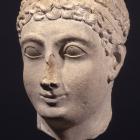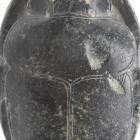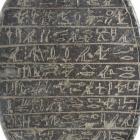The early 19th century nucleus of what would become the Egyptian Collection of the Milanese Archaeological Museum, was composed of the mummy of a male (the so called “Busca” mummy), some fragments of papyrus, which perhaps belonged to the collection of the French consul to Egypt, Bernardino Drovetti and the donation by Austria’s consul to Egypt, Giuseppe Acerbi - which includes the mummy, sarcophagus and coffin of Peftjauauyaset . At the time, the collection was divided between two distinct institutions, both located in the current palazzo di Brera, the Numismatic Cabinet and Braidense Library.
In 1901 the exhibits merged to form the egyptian collection, which had been slowly coming together within the Museo Patrio di Archeologia, the predecessor of the current Civic Museums. Established in 1862 and initially housed in the same location, palazzo di Brera, the Museo Patrio was transferred to the Sforza Castle in 1900.
The Emilio Saletti bequest and the Achille Vogliano excavation
The Milanese egyptian collection rapidly increased in size over the following decades thanks to continuous donations from small and medium-sized collections, including those of Emilio Seletti, one of the most active members of the trust of theMuseo Patrio. It especially benefited from materials found during the excavations directed by papyrologist Achille Vogliano between 1934 and 1939 in the two sites of Tebtynis and Medînet Mâdi (both in Fayum), under the auspices of the Civic Museum and the University of Milan.
From the post-war period to now
During the Second World War the Castle exhibits were dismantled and the materials placed in warehouses. Only in 1965 were the archaeological collections moved from the Castle to the present seat in Corso Magenta, with the exception of the prehistoric and egyptian collections. The artefacts belonging to the latter, thanks to the then director of the Civic Archaeological Collections, Gian Guido Belloni, were recovered, catalogued, restored and prepared for a new thematic exhibition, which was inaugurated in 1973, in the basement of the Rocchetta courtyard of the Castle. Cesare Volpiano’s mounting provided for two rooms, the first focused on the funerary cult, the second on daily life, religion and art in ancient Egypt. In the following forty years, continuous donations from individuals as well as targeted acquisitions, led to a further expansion of the city of Milan’s Egyptian collection, which now counts approximately 3,000 exhibits.
As part of wider renovation works on the Castle, the permanent exhibition of the egyptian collection was remounted in early 2003 in its current location, the basement of the Ducal Court.










